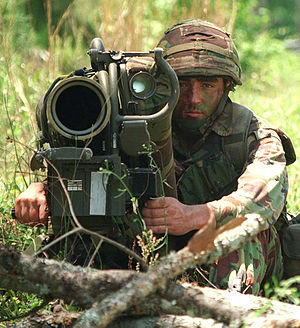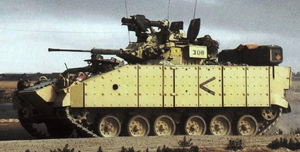Vanguard missile: Difference between revisions
Ozycaevias (talk | contribs) m (1 revision imported: Ajax category without templates) |
Arthurista (talk | contribs) (Undo revision 476239 by Arthurista (talk)) Tag: Undo |
||
| (4 intermediate revisions by the same user not shown) | |||
| Line 1: | Line 1: | ||
{{Infobox weapon | {{Infobox weapon | ||
|is_missile=yes | |is_missile=yes | ||
|image= [[File: | |image= [[File:British Royal Marine with anti-tank weapon.jpg|300px]] | ||
|caption= Vanguard ATGM | |caption= Vanguard ATGM | ||
|name= Vanguard ATGM | |name= Vanguard ATGM | ||
| Line 19: | Line 19: | ||
|weight= 14kg | |weight= 14kg | ||
|speed= | |speed= | ||
|vehicle_range= 2.5km | |vehicle_range= 2-2.5km | ||
|ceiling= | |ceiling= | ||
|filling= | |filling= Shaped-charge | ||
|detonation= | |detonation= | ||
|engine=solid-fuel rocket | |engine=solid-fuel rocket | ||
|steering= | |steering= | ||
| Line 32: | Line 32: | ||
The Vanguard is a model of wire-guided anti-tank guided missiles which was introduced in the mid-70s in the [[Commonwealth Army]], replacing {{wp|Vickers Vigilant|Vigilant ATGM}} and {{wp|120 mm BAT recoilless rifle|L6 Wombat}} as the main anti-tank weapon of the Arthuristan infantry battalion. It is a relatively economical weapon which remains in service in large numbers. Plans have been made to replace the Vanguard with a man-portable [[Vesper missile]]. However, due to the high cost of such a munition, the process is gradual at best and significant stocks of Vanguard missiles remain in service. | The Vanguard is a model of wire-guided anti-tank guided missiles which was introduced in the mid-70s in the [[Commonwealth Army]], replacing {{wp|Vickers Vigilant|Vigilant ATGM}} and {{wp|120 mm BAT recoilless rifle|L6 Wombat}} as the main anti-tank weapon of the Arthuristan infantry battalion. It is a relatively economical weapon which remains in service in large numbers. Plans have been made to replace the Vanguard with a man-portable [[Vesper missile]]. However, due to the high cost of such a munition, the process is gradual at best and significant stocks of Vanguard missiles remain in service. | ||
The first generation of the weapon, '''Vanguard Mk 1''', was introduced in 1975 as a straightforward wire-guided SACLOS missile | The first generation of the weapon, '''Vanguard Mk 1''', was introduced in 1975 as a straightforward wire-guided SACLOS missile. The missile is guided by the operator keeping the crosshair of his firing post's sight on the target, which will then cause the firing post to steer the missile towards it. Accordingly, it is much simpler and easier to operate compared to previous generation manually-guided weapons. The '''Mk 1A''' features a thermal sight to identify and engage targets at night and a missile with an increased diameter, conferring upon it enhanced penetration capabilities at 550mm RHA. | ||
[[File:Claymore MILAN.png|thumb|left|300px|A [[Claymore Infantry Fighting Vehicle|Claymore IFV]] with pintle-mounted Vanguard missile firing post]] | [[File:Claymore MILAN.png|thumb|left|300px|A [[Claymore Infantry Fighting Vehicle|Claymore IFV]] with pintle-mounted Vanguard missile firing post]] | ||
The '''Vanguard Mk 2''' | The '''Vanguard Mk 2''' entered service in the late-80's in response to the proliferation of {{Wp|Explosive reactive armour|explosive reactive armour}} and new generations of {{wp| Composite armour|composite armour}} used to protect the latest main battle tanks. It features a larger tandem warhead capable of penetrating 880mm of RHA and capable of defeating most light to medium explosive reactive armour suites. It also replaces the missile's thermal flare, which is used by the firing post to track the missile along its flight path, with a backward-directed coded laser beacon, which in combination with improved signals-processing renders it very difficult to jam by most {{Wp|Shtora|soft-kill active countermeasures}}. | ||
The current '''Vanguard Mk 3''', introduced in the mid-2000s, features a number of minor enhancements. It has an enhanced un-cooled third generation thermal imaging sight for improved night engagement capabilities. | The current '''Vanguard Mk 3''', introduced in the mid-2000s, features a number of minor enhancements. It features a missile with extended range (2.5km) and an improved tandem warhead (1,000mm RHA). It has an enhanced un-cooled third generation thermal imaging sight for improved night engagement capabilities. | ||
Many Arthuristan combat vehicles, such as the [[Claymore Infantry Fighting Vehicle|Claymore IFV]], feature the Vanguard missile as a pintle mount. As an infantry weapon, the firing post is normally mounted on a low-profile tripod, although in an emergency it may be shoulder-launched. A 'pop' motor pushes the missile forward and the launch tube to the rear before the rocket motor is ignited. A missile, sealed inside its waterproof launch tube, is counted as a unit of ammunition. A remote-controlled mount which features two detachable [[Vesper missile]]s and a machine gun is slowly replacing the Vanguard. | Many Arthuristan combat vehicles, such as the [[Claymore Infantry Fighting Vehicle|Claymore IFV]], feature the Vanguard missile as a pintle mount. As an infantry weapon, the firing post is normally mounted on a low-profile tripod, although in an emergency it may be shoulder-launched. A 'pop' motor pushes the missile forward and the launch tube to the rear before the rocket motor is ignited. A missile, sealed inside its waterproof launch tube, is counted as a unit of ammunition. A remote-controlled mount which features two detachable [[Vesper missile]]s and a machine gun is slowly replacing the Vanguard. | ||
Latest revision as of 03:15, 20 March 2022
| Vanguard ATGM | |
|---|---|
 Vanguard ATGM | |
| Type | Anti-tank missile |
| Place of origin | Arthurista |
| Service history | |
| In service | 1977-present |
| Production history | |
| Manufacturer | Arthuristan Dynamics |
| Variants | see text |
| Specifications | |
| Weight | 14kg |
| Diameter | 150mm |
| Warhead | Shaped-charge |
| Engine | solid-fuel rocket |
Operational range | 2-2.5km |
Guidance system | wire-guided SACLOS |
Launch platform | Infantry, vehicles, helicopter, fixed-wing aircrafts |
The Vanguard is a model of wire-guided anti-tank guided missiles which was introduced in the mid-70s in the Commonwealth Army, replacing Vigilant ATGM and L6 Wombat as the main anti-tank weapon of the Arthuristan infantry battalion. It is a relatively economical weapon which remains in service in large numbers. Plans have been made to replace the Vanguard with a man-portable Vesper missile. However, due to the high cost of such a munition, the process is gradual at best and significant stocks of Vanguard missiles remain in service.
The first generation of the weapon, Vanguard Mk 1, was introduced in 1975 as a straightforward wire-guided SACLOS missile. The missile is guided by the operator keeping the crosshair of his firing post's sight on the target, which will then cause the firing post to steer the missile towards it. Accordingly, it is much simpler and easier to operate compared to previous generation manually-guided weapons. The Mk 1A features a thermal sight to identify and engage targets at night and a missile with an increased diameter, conferring upon it enhanced penetration capabilities at 550mm RHA.

The Vanguard Mk 2 entered service in the late-80's in response to the proliferation of explosive reactive armour and new generations of composite armour used to protect the latest main battle tanks. It features a larger tandem warhead capable of penetrating 880mm of RHA and capable of defeating most light to medium explosive reactive armour suites. It also replaces the missile's thermal flare, which is used by the firing post to track the missile along its flight path, with a backward-directed coded laser beacon, which in combination with improved signals-processing renders it very difficult to jam by most soft-kill active countermeasures.
The current Vanguard Mk 3, introduced in the mid-2000s, features a number of minor enhancements. It features a missile with extended range (2.5km) and an improved tandem warhead (1,000mm RHA). It has an enhanced un-cooled third generation thermal imaging sight for improved night engagement capabilities.
Many Arthuristan combat vehicles, such as the Claymore IFV, feature the Vanguard missile as a pintle mount. As an infantry weapon, the firing post is normally mounted on a low-profile tripod, although in an emergency it may be shoulder-launched. A 'pop' motor pushes the missile forward and the launch tube to the rear before the rocket motor is ignited. A missile, sealed inside its waterproof launch tube, is counted as a unit of ammunition. A remote-controlled mount which features two detachable Vesper missiles and a machine gun is slowly replacing the Vanguard.
In light infantry deployment, an individual soldier may routinely manhandle up to two rounds and supply ammunition to the gunner operating the firing post.